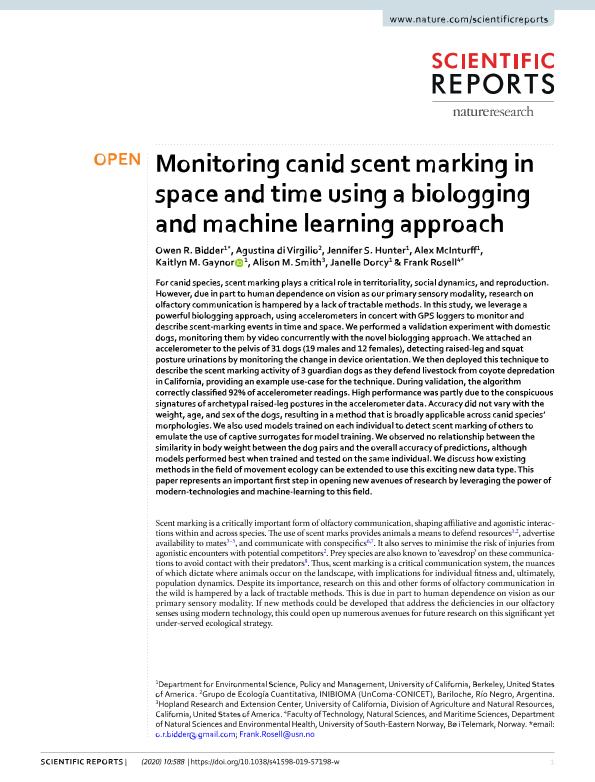Mostrar el registro sencillo del ítem
dc.contributor.author
Bidder, Owen
dc.contributor.author
Di Virgilio, Agustina Soledad

dc.contributor.author
Hunter, Jennifer
dc.contributor.author
McInturff, Alex
dc.contributor.author
Gaynor, Kaitlyn

dc.contributor.author
Smith, Alison
dc.contributor.author
Dorcy, Janelle
dc.contributor.author
Rosell, Frank
dc.date.available
2020-07-02T15:50:15Z
dc.date.issued
2020-02
dc.identifier.citation
Bidder, Owen; Di Virgilio, Agustina Soledad; Hunter, Jennifer; McInturff, Alex; Gaynor, Kaitlyn; et al.; Monitoring canid scent marking in space and time using a biologging and machine learning approach; Nature Publishing Group; Scientific Reports; 10; 2-2020; 1-13
dc.identifier.issn
2045-2322
dc.identifier.uri
http://hdl.handle.net/11336/108669
dc.description.abstract
For canid species, scent marking plays a critical role in territoriality, social dynamics, and reproduction. However, due in part to human dependence on vision as our primary sensory modality, research on olfactory communication is hampered by a lack of tractable methods. In this study, we leverage a powerful biologging approach, using accelerometers in concert with GPS loggers to monitor and describe scent-marking events in time and space. We performed a validation experiment with domestic dogs, monitoring them by video concurrently with the novel biologging approach. We attached an accelerometer to the pelvis of 31 dogs (19 males and 12 females), detecting raised-leg and squat posture urinations by monitoring the change in device orientation. We then deployed this technique to describe the scent marking activity of 3 guardian dogs as they defend livestock from coyote depredation in California, providing an example use-case for the technique. During validation, the algorithm correctly classifed 92% of accelerometer readings. High performance was partly due to the conspicuous signatures of archetypal raised-leg postures in the accelerometer data. Accuracy did not vary with the weight, age, and sex of the dogs, resulting in a method that is broadly applicable across canid species’ morphologies. We also used models trained on each individual to detect scent marking of others to emulate the use of captive surrogates for model training. We observed no relationship between the similarity in body weight between the dog pairs and the overall accuracy of predictions, although models performed best when trained and tested on the same individual. We discuss how existing methods in the feld of movement ecology can be extended to use this exciting new data type. This paper represents an important frst step in opening new avenues of research by leveraging the power of modern-technologies and machine-learning to this feld
dc.format
application/pdf
dc.language.iso
eng
dc.publisher
Nature Publishing Group

dc.rights
info:eu-repo/semantics/openAccess
dc.rights.uri
https://creativecommons.org/licenses/by/2.5/ar/
dc.subject
MACHINE LEARNING
dc.subject
SCENT MARKING
dc.subject
CANIDS
dc.subject
LIVESTOCK GUARDIAN DOG
dc.subject.classification
Conservación de la Biodiversidad

dc.subject.classification
Ciencias Biológicas

dc.subject.classification
CIENCIAS NATURALES Y EXACTAS

dc.title
Monitoring canid scent marking in space and time using a biologging and machine learning approach
dc.type
info:eu-repo/semantics/article
dc.type
info:ar-repo/semantics/artículo
dc.type
info:eu-repo/semantics/publishedVersion
dc.date.updated
2020-06-08T15:13:12Z
dc.identifier.eissn
2045-2322
dc.journal.volume
10
dc.journal.pagination
1-13
dc.journal.pais
Alemania

dc.journal.ciudad
Berlín
dc.description.fil
Fil: Bidder, Owen. University of California at Berkeley; Estados Unidos
dc.description.fil
Fil: Di Virgilio, Agustina Soledad. Consejo Nacional de Investigaciones Científicas y Técnicas. Centro Científico Tecnológico Conicet - Patagonia Norte. Instituto de Investigaciones en Biodiversidad y Medioambiente. Universidad Nacional del Comahue. Centro Regional Universidad Bariloche. Instituto de Investigaciones en Biodiversidad y Medioambiente; Argentina
dc.description.fil
Fil: Hunter, Jennifer. University of California at Berkeley; Estados Unidos
dc.description.fil
Fil: McInturff, Alex. University of California at Berkeley; Estados Unidos
dc.description.fil
Fil: Gaynor, Kaitlyn. University of California at Berkeley; Estados Unidos
dc.description.fil
Fil: Smith, Alison. University of California at Berkeley; Estados Unidos
dc.description.fil
Fil: Dorcy, Janelle. University of California at Berkeley; Estados Unidos
dc.description.fil
Fil: Rosell, Frank. University of South-Eastern Norway; Noruega
dc.journal.title
Scientific Reports
dc.relation.alternativeid
info:eu-repo/semantics/altIdentifier/url/https://www.nature.com/articles/s41598-019-57198-w
dc.relation.alternativeid
info:eu-repo/semantics/altIdentifier/doi/http://dx.doi.org/10.1038/s41598-019-57198-w
Archivos asociados
